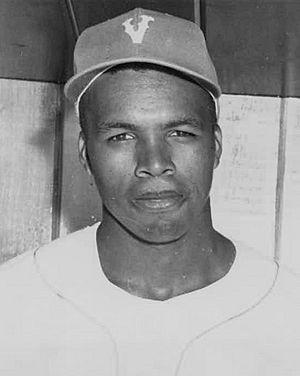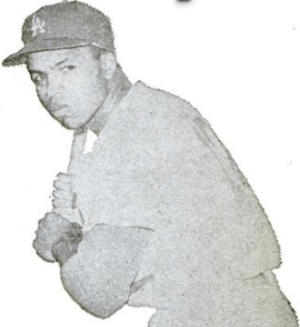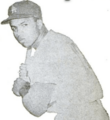Tommy Davis (outfielder) facts for kids
Quick facts for kids Tommy Davis |
|||
|---|---|---|---|

Davis in 1958
|
|||
| Left fielder / Designated hitter | |||
| Born: March 21, 1939 Brooklyn, New York |
|||
| Died: April 3, 2022 (aged 83) Phoenix, Arizona |
|||
|
|||
| debut | |||
| September 22, 1959, for the Los Angeles Dodgers | |||
| Last appearance | |||
| October 2, 1976, for the Kansas City Royals | |||
| MLB statistics | |||
| Batting average | .294 | ||
| Hits | 2,107 | ||
| Home runs | 153 | ||
| Runs batted in | 1,052 | ||
| Teams | |||
|
|||
| Career highlights and awards | |||
|
|||
Tommy Davis (born March 21, 1939 – died April 3, 2022) was a famous American baseball player and coach. He played in Major League Baseball (MLB) from 1959 to 1976. He was mostly a left fielder for ten different teams. He is best known for his time with the Los Angeles Dodgers. With the Dodgers, he won two batting titles and helped them win the 1963 World Series.
Over his 18-year career, Tommy had a batting average of .294. He hit 153 home runs, made 2,121 hits, and brought in 1,052 runs for his team. He was also great at pinch-hitting. In 1962, he was one of the best players in the league. He led all of MLB in batting average, hits, and runs batted in. He finished third in the vote for the MVP award. His 153 RBIs that year are still a record for the Dodgers team.
Contents
Tommy Davis's Baseball Journey
Early Life and Start in Baseball
Tommy Davis was born in Brooklyn, New York. He grew up in the Bedford–Stuyvesant area of Brooklyn. He went to Boys High School. There, he played basketball with future Hall of Famer Lenny Wilkens. He was also a long jumper on the school's track and field team.
In 1956, Tommy thought about signing with the New York Yankees. But then, Jackie Robinson called him. Jackie convinced him to sign with the Brooklyn Dodgers instead. In his minor league career, Tommy won batting titles in two different leagues.
Becoming a Star with the Dodgers
By the time Tommy Davis joined the major leagues, the Dodgers had moved to Los Angeles. He played his first game on September 22, 1959. He had a good rookie year in 1960, batting .276. In 1961, he batted .278.
His best year was 1962, when the team moved into the new Dodger Stadium. He hit for a .346 batting average. This was the best in the National League. He also led all of MLB with 230 hits and 153 RBIs. He hit 27 home runs, scored 120 runs, and had 9 triples. The Dodgers tied for first place that year but lost in a playoff. Tommy finished third in the MVP voting.
In 1963, Tommy won his second straight batting title. He helped the Dodgers sweep the New York Yankees in the 1963 World Series. He batted .400 in the Series. He drove in the only run in their 1–0 win in Game 3.
Tommy Davis is the only Dodgers player in Los Angeles history to win two batting titles in a row. He did this while playing at Dodger Stadium. This park is known for being harder for hitters.
Injuries and Moving Teams
In 1964, Tommy's batting average dropped to .275. On May 1, 1965, he broke his ankle sliding into second base. This injury kept him out for most of the season. The Dodgers still won the 1965 World Series that year. Tommy came back strong in 1966, batting .313. But the Dodgers lost the 1966 World Series to the Baltimore Orioles.
After 1966, Tommy was traded to the New York Mets. He batted .302 with 16 home runs in 1967. Then he was traded again to the Chicago White Sox. In 1968, he led the White Sox in hitting with a .268 average.
Playing for Many Teams
In October 1968, Tommy was chosen by the Seattle Pilots in a special draft. He played for the Pilots in 1969 before being traded to the Houston Astros. He had a career high of 20 stolen bases that year.
He then played for the Oakland Athletics and the Chicago Cubs in 1970. He had a great year in 1971, batting .324 for the Athletics. After being released, he signed with the Cubs again in 1972. Soon after, he was traded to the Baltimore Orioles.
With the Orioles, he played as the designated hitter from 1973 to 1975. He finished third in the batting race in 1973 with a .306 average. In 1974, he had the second most hits in the American League. He also won the Outstanding Designated Hitter Award that year. He played in two American League Championship Series with the Orioles.
Tommy Davis played for ten different teams in his 18-year career. He retired after the 1976 season. After he stopped playing, he worked as a Seattle Mariners coach in 1981.
Images for kids




